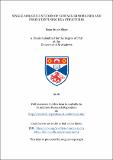Files in this item
Single-molecule studies of surface-immobilised and freely diffusing RNA structures
Item metadata
| dc.contributor.advisor | Penedo, Carlos | |
| dc.contributor.author | Shaw, Euan Stuart | |
| dc.coverage.spatial | xiv, 328 p. | en_US |
| dc.date.accessioned | 2018-03-20T09:28:21Z | |
| dc.date.available | 2018-03-20T09:28:21Z | |
| dc.date.issued | 2016-06-22 | |
| dc.identifier.uri | https://hdl.handle.net/10023/12974 | |
| dc.description.abstract | During the process of transcription, a messenger RNA (mRNA) copy of the genetic information encoded in the DNA is built. As mRNA is constructed, secondary and tertiary motifs may form, which combine into intricate structures through a process called RNA folding, enabling RNA to perform biological functions beyond transporting genetic information, including gene regulation and catalytic self- cleaving processes. Facilitating RNA folding are divalent ions, located site- specifically within the structure, and monovalent ions which bind non-specifically to the phosphate backbone, shielding the negative charge and allowing the motifs to move into close proximity and interact. Three-way RNA junctions are among the smallest biologically-active RNA structures and are known to mediate both gene regulatory and catalytic processes. In the first part of this thesis, I use single- molecule total-internal reflection fluorescence microscopy with Förster resonance energy transfer (TIRFM-FRET) to characterise the folding and function of two of these structures: the adenine riboswitch and the hammerhead ribozyme. Using single-molecule Förster resonance energy transfer (sm-FRET), I extract information on both the prevalent conformations of these molecules at specific chemical conditions and kinetic information on structural rearrangements which occurr on both the molecular and global levels. Building on this knowledge built up of the folding pathway of the adenine riboswitch induced by monovalent ions, I moved to develop a method in which the competing interplay between monovalent ions and urea, an unfolding reagent, is exploited to isolate and overpopulate a transient intermediate state identified on the folding pathway. Although chemical denaturants are commonly used to investigate the structures of proteins, their application to RNA folding is still in its infancy. For the first time, I demonstrate that this approach allows the manipulation of the folding dynamics of RNA, forcing the structure into a state which is ordinarily poorly-populated. I speculate that this could enable a detailed characterisation of these states by NMR and other high resolution ensemble techniques. Finally, I move on to expanding the range of single-molecule techniques available in St Andrews. Despite the power of single- molecule TIRFM-FRET, it requires surface immobilisation, which can compromise biological function through further modifications to the natural form of the sample under investigation. To overcome this problem, I implement single-molecule fluorescence correlation spectroscopy (sm-FCS), which probes freely diffusing samples in solution. After testing this sm-FCS system various test structures, I upgrade it for dual-colour fluorescence cross-correlation spectroscopy (sm-FCCS), and finally to multi-parameter fluorescence detection (sm-MFD), where the fluorescence lifetime of the sample is also returned. The capabilities of these three techniques are tested by examining protein-DNA interactions, RNA structure and vesicle morphology. | en |
| dc.language.iso | en | en_US |
| dc.publisher | University of St Andrews | |
| dc.subject.lcc | QP623.S52 | |
| dc.title | Single-molecule studies of surface-immobilised and freely diffusing RNA structures | en_US |
| dc.type | Thesis | en_US |
| dc.contributor.sponsor | Engineering and Physical Sciences Research Council (EPSRC) | en_US |
| dc.type.qualificationlevel | Doctoral | en_US |
| dc.type.qualificationname | PhD Doctor of Philosophy | en_US |
| dc.publisher.institution | The University of St Andrews | en_US |
| dc.identifier.doi | https://doi.org/10.17630/10023-12974 |
This item appears in the following Collection(s)
Items in the St Andrews Research Repository are protected by copyright, with all rights reserved, unless otherwise indicated.

